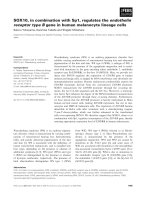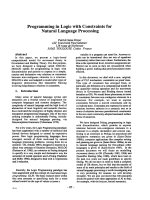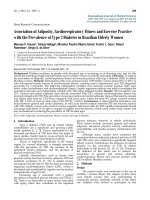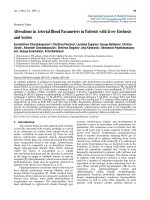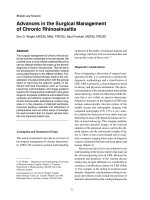Báo cáo y học: "Infliximab in ankylosing spondylitis: alone or in combination with methotrexate? A pharmacokinetic comparative study" ppt
Bạn đang xem bản rút gọn của tài liệu. Xem và tải ngay bản đầy đủ của tài liệu tại đây (216.79 KB, 5 trang )
RESEARCH ARTICLE Open Access
Infliximab in ankylosing spondylitis: alone or in
combination with methotrexate? A pharmacokinetic
comparative study
Denis Mulleman
1,2*
, Francine Lauféron
1,2
, Daniel Wendling
3,4
, David Ternant
1,5
, Emilie Ducourau
1,2
,
Gilles Paintaud
1,5
and Philippe Goupille
1,2,6
Abstract
Introduction: Methotrexate (MTX) has been shown to modify infliximab pharmacokinetics in rheumatoid arthritis.
However, its combination with infliximab in the treatment of ankylosing spondylitis (AS) is not recommended. The
objective of this study was to examine the influence of MTX on infliximab exposure in patients with AS.
Methods: Patients with AS patients who had predominantly axial symptoms were randomised to receive infliximab
alone (infusions of 5 mg/kg at weeks 0, 2, 6, 12 and 18) or infliximab combined with MTX (10 mg/week). Infliximab
concentrations were measured before and 2 hours after each infusion and at 1, 3, 4, 5, 8, 10, 14 and 18 weeks. We
estimated individual cumulative area under the concentration versus time curves (AUC) for infliximab concentration
between baseline and week 18 (AUC
0-18
). Clinical and laboratory evaluations were performed at each visit. The Bath
Ankylosing Spondylitis Disease Activity Index (BASDAI) score was the primary end point for clinical response.
Results: Twenty-six patients were included (infliximab group: n = 12, infliximab + MTX group: n = 14), and 507
serum samples were available for measurement of infliximab concentration. The two groups did not differ with
regard to AUC
0-18
or evolution of BASDAI scores and biomarkers of inflammation.
Conclusions: The combination of MTX and infliximab does not increase the exposure to infliximab over infliximab
alone in patients with AS.
Trial registration: ClinicalTrials.gov: NCT00507403
Introduction
Infliximab, a chimeric monoclonal antibody to TNF-a,
showed efficacy for ankylosing spondylitis (AS) in a ran-
domised, placebo-controlled trial in which 61.2% of the
patients were responders at 24 weeks [ 1]. Although
methotrexate (MTX) is often used for patients with pre-
dominantly peripheral AS and those with psoriatic
arthritis, the few attempts to treat predominantly axial
disease were disappointing. Haibel et al.[2]studied20
patients with AS who received MTX 15 to 20 mg/week
subcutaneously and found no difference in Assessment
in Ankylosing Spondylitis 20% improvement criteria
(ASAS 20) scores before and 16 weeks after treatment.
Until now, MTX has been evaluated in only three small,
randomised, controlled trials [3-5], and a Cochrane
review [6] concluded that there was insufficient evidence
to support the use of MTX for AS with predominantly
axial symptoms.
Data comparing infliximab with and without MTX
treatment in AS are sparse and conflicting. Pérez-Guijo
et al. [7] found a greater reduction in Bath Ankylosing
Spondylitis Disease Activity Index (BASDAI) scores with
infliximab + MTX treatment than with infliximab alone,
whereas Breban et al. [8] found no statistically signifi-
cant difference between patients who did or did not
receive MTX in a subset of AS patients receiving treat-
ment with infliximab by an on-demand strategy. How-
ever, in the latter study, patients receiving MTX showed
a better response and fewer reactions to infusions than
* Correspondence:
1
Université François-Rabelais de Tours, Centre National de la Recherche
Scientifique UMR 6239 GICC (Génétique Immunothérapie Chimie et Cancer),
3 rue des Tanneurs, F-37041 Tours Cedex 1, France
Full list of author information is available at the end of the article
Mulleman et al. Arthritis Research & Therapy 2011, 13:R82
/>© 2011 Mulleman et al. licensee BioMed Central Ltd. This is an open access article distributed under the terms of the Creative
Commons Attribution License (http://cre ativecommons.org/licenses/by/ 2.0), which permits u nrestri cted use, di stribution, and
reproduction in any medium, provided the original work is properly cited.
did patients not receiving MTX, although the results
were not statistically significant [8]. Currently, regardi ng
TNF-a antagoni st therapy for patients with AS or psor-
iatic arthritis, the French Society for Rheuma tology
recommendations suggest that there is insufficient evi-
dence for concomitant disease-modifying antirheumatic
drugs improving t he effectiveness of TNF-a antagonist
therapy [9].
To date, no study has used infliximab exposure as an
end point to compare treatment with the combination
of infliximab and MTX with infliximab alone in AS with
predominantly axial symptoms. Indeed, if such a combi-
nation increases exposure to infliximab, it should
improve response and may be recommended in clinical
practice. In the present study, we compared the indivi-
dual exposure to infliximab of AS patients with predo-
minantly axial symptoms receiving infliximab alone or
infliximab and MTX combined.
Materials and methods
Patients and study protocol
From January 2008 to April 2009, AS patients with pre-
dominantly axial symptoms were recruited to participate
in this two-centre, open-label, prospective, randomised
study comparing treatment with infliximab alone and
inflixima b with MTX. Al l patients fulfi lled the New Yo rk
revised cri teria for AS [10]. Infliximab wa s given intrave-
nously (5 mg/kg) at weeks 0, 2, 6, 12 and 18 in accor-
dance with our guidelines [9]. MTX 10 mg was given
orally every week. After patients were randomised to a
treatment group, a total of 12 visits were scheduled at
each infliximab infusion and between infusions at 1, 3, 4,
5, 8, 10 and 14 wee ks. Blood samples were collected
before and two hours after the end of each infusion and
at each visit. We estimated that we needed about 30
patients to compare infliximab exposure between the two
treatment groups. The study protocol was in compliance
with the Declaration of Helsinki, approved by t he ethic
committee of Tours University Hospital and registered
(ClinicalTrials.gov ID: NCT00507403). All patients gave
their informed consent to participate in the study.
Clinical measurements
At each visit, patients were asked to complete a BASDAI
questionnaire and were classified as responders if their
BASDAIscore(ona10-pointscale)atweek18wastwo
points lower than at baseline [9,11] . Treatment response
was also assessed according to the Assessment in Anky-
losing Spondylitis 20% improvement criteria (ASAS 20).
Serum infliximab and antibodies toward infliximab
concentrations
Analyses of serum infliximab and antibody toward
infliximab (ATI) concentrations were centralised in
Tours University Hospital. Infliximab serum concentra-
tion was measured in samples by using ELISA as
described previously [12]. Serum concentration of ATI
was measured by using a double-antigen ELISA on the
basis of capture by infliximab-coated microplates and
detection by peroxidase-conjugated infliximab. This
ass ay was standardised by the use of a mouse monoclo-
nal antibody against human immunoglobulin G. The
positive threshold of detection was 0.07 mg/L. Because
of the interference of circulating infliximab, only sera
with infliximab concentrations < 2 mg/L were tested.
Statistical analysis
Individual exposure to infliximab was estimated by the
cumulative area under the concentration versus time
curve between baseline and week 18 (AUC
0-18
) by popu-
lation pharmacokinetics modelling . The best description
of infliximab concentrations was o btained by use of a
two-compartment model with first-order distribution
and elimination constants. Characteristics at baseline
and the proportion of responders in each group were
compared by using nonparametric tests. The results are
presented in Table 1 as medians [range] unless other-
wise stated. Statistical analysis involved the use of R
2.7.2 software [13].
Results
We included 26 patients: 12 in the infliximab -only group
and 14 in the infliximab + MTX group. The patients’ char-
acteristics at baseline are given in T able 1. A total of 507
samples were available for measurement of serum inflixi-
mab concentrations. Individual AUC
0-18
results for
Table 1 Baseline characteristics of 26 patients with
ankylosing spondylitis and predominantly axial
symptoms randomised to receive infliximab or infliximab
+ methotrexate
a
Characteristics Infliximab
(n = 12)
Infliximab +
MTX
(n = 14)
P
value
Sex, men/women (n/%) 9/3 (75/25) 11/3 (79/21) 0.8
Median age, years 42.5 [27 to
59]
45.5 [29 to 55] 0.3
Median disease duration, years 4.0 [0 to 28] 4.5 [1 to 19] 0.9
Human leukocyte antigen B27
+
,
n (%)
9 (75) 10 (71) 0.8
NSAIDs, n (%) 8 (67) 12 (86) 0.5
Previous TNF-a, n (%) 2 (17) 2 (14) 1.0
Median BASDAI score 5.8 [3.9 to
8.4]
7.0 [5.0 to 8.2] 0.2
Median C-reactive protein, mg/L 3.6 [0.5 to
18.0]
2.7 [0.5 to
31.2]
0.5
a
MTX: methotrexate; BASDAI: Bath Ankylosing Spondylit is Disease Activity
Index; NSAIDs: nonsteroidal anti-inflammatory drugs. Results are given as
medians [range] unless otherwise indicated.
Mulleman et al. Arthritis Research & Therapy 2011, 13:R82
/>Page 2 of 5
infliximab are shown in Figure 1. The two treatment
groups did not differ in terms o f AUC
0-18
results. The
median AUC
0-18
value was 165,502 mg/hour/L [50,569 to
203,782] for the in fliximab-only grou p and 164,222 mg/
hour/L [102,165 to 295,858] for the infliximab + MTX
group. Likewise, MTX had no effect on estimated pharma-
cokinetics parameters (data not shown). Positivity for ATI
was detected in only one patient, a 43-year-old woman in
the infliximab-only group who was nega tive for human
leukocyte antigen B27. At weeks 4, 5 and 6, her infliximab
concentrations were < 1 mg/L and ATIs were detected at
weeks 12 and 18. Her exposure to infliximab was l ow
(AUC
0-18
= 50,569 mg/hour/L), and the infliximab elimi-
nat ion clearance was twice that of ATI-negative patients
(data not shown).
The two groups did not differ with regard to clinical
activity or inflammation. Responses between the two
groups were similar at week 18 (Additional file 1).
Responders displayed a rapid decrease in BASDAI score
compared with nonresponders , with a statistically signif-
icant difference observed at week 6 and thereafter
(Additional file 2). The proportions of previous anti-
TNF-a and current NSAIDs were similar in both
responders and nonresponders.
Discussion
We did not observe any influence of MTX on infliximab
exposure in AS patients with predominantly axial
symptoms. Our study is the first to answer the question
whether MTX may affect infliximab pharmacokinetics in
AS with predominantly axial sympto ms. Previously, Kri-
siek et al. [14] analysed blood samples from AS patients
receiving treatment with infliximab by an on-demand
strategy with or without MTX. In their post hoc analysis
involving 34 patients receiving MTX and 42 patients not
receiving MTX, infliximab concentrations were mea-
suredatweeks2and6aftertreatment.Theauthors
found no significant difference in infliximab levels
between the two groups. Our results are in agreement
withthesepreviouslypublishedresultsandprovidea
precise estimation of the drug exposure w ith repeated
and prolonged measurement of infliximab.
We found no difference between treatment groups
with regard to change in BASDAI scores or ASAS 20
criteria, findings which are in agreement with results
from previous controlled trials [3-5]. Although clinical
outcome was not our objective, our results do not argue
for a clinical benefit of adding MTX t o infliximab treat-
ment (5 mg/kg/infusion) for AS with predominantly
axial symptoms. Patients who were responders at week
18 showed a rapid decrease in BASDAI scores, which
suggests that an early decrease in BASDAI score may
predict a response later on . By cont rast, a patien t who
has not responded at 6 weeks after initiation seems
likely to be a primary nonresponder.
The MTX dosage we used, 10 mg/week orally, was in
agreement w ith the recommendation by an expert o pi-
nion of a broad international panel of rheumatologists
[15]. A subcutaneous route or higher dosage t han 10
mg/week would not likely have changed our results,
because a previous study found no clinical response in
patients with AS receiving MTX 15 to 20 mg/week sub-
cutaneously [2].
We observed an important variability in infliximab
exposure in both groups of patients. This variability has
been reported in previous studies in which trough con-
centration was measured [14,16]. Our study provides a
more precise characterisation of this variability and con-
firms that exposure to treatment differs considerably
among individuals.
We found that one patient was positive for ATI. Of
note, this patient did not receive MTX, and this finding
raises the question o f the hypothetical role of immuno-
suppressive agents in preventing immunisation as
reported in rheumatoid arthritis (RA) and Crohn’ sdis-
ease [17-19]. Because of the small number of partici-
pants and the relatively short duration of the study, no
conclusion can be dr awn regarding the potential role of
MTX in reducing immunogenicity in AS.
Our results differ from those of Mai ni et al. [17], who
found that MTX increased infliximab concentrations in
RA. In RA, disease activity at baseline was found to be
150000
200000
250000
300000
0
-18
(mg.h/L)
0
50000
100000
AUC
0
Infliximab Infliximab
+
MTX
Figure 1 Area under the concentration curve versus the time
curve for serum infliximab concentration between baseline
and week 18 (AUC
0-18
) for patients with ankylosing spondylitis
who had predominantly axial symptoms and were receiving
infliximab or infliximab + methotrexate (MTX) treatment. The
patient with anti-infliximab antibodies is shown as an open circle.
Mulleman et al. Arthritis Research & Therapy 2011, 13:R82
/>Page 3 of 5
negatively associated with infliximab trough concentra-
tion at 6 weeks after initiation of treatment [20,21]. This
phenomenon may be explained by target ed mediated-
drug disposition and high levels of TNF-a (which corre-
sponds to antigenic burden) binding infliximab, which
influence its pharmac okinetics. MTX is ef fective as
monotherapy in patients with RA by decreasing TNF-a
levels, which in turn increase infliximab concentrations
[17]. That MTX did not improve infliximab exposure in
our study patients with AS who had predominantly axial
symptoms may reflect the fact that TNF-a antigenic
burden is lower in AS than in RA.
Conclusion
MTX seems to have no significant effect on infliximab
pharmacokinetics in AS with predomi nantly axial symp-
toms. These results do not argue for adding MTX to
infliximab therapy in this condition.
Additional material
Additional file 1: Figure S1. Percentage of responders according to
Bath Ankylosing Spondylitis Disease Activity Index (BASDAI) score ( > 2-
point reduction between baseline and week 18) and Assessment in
Ankylosing Spondylitis 20% improvement criteria (ASAS 20) for patients
with ankylosing spondylitis who had predominantly axial symptoms and
were receiving infliximab or infliximab + methotrexate (MTX) treatment.
Additional file 2: Figure S2. Changes in BASDAI scores for treatment
responders (filled circles; n = 12) and nonresponders (open circles; n =
14) receiving infliximab alone or infliximab + methotrexate treatment.
†
P
< 0.05.
‡
P < 0.01.
Abbreviations
AS: ankylosing spondylitis; ASAS 20: Assessment in Ankylosing Spondylitis
20% improvement criteria; ATI: antibody toward infliximab; AUC: area under
the concentration versus time curve; BASDAI: Bath Ankylosing Spondylitis
Disease Activity Index; ELISA: enzyme-linked immunosorbent assay; MTX:
methotrexate; NSAID: nonsteroidal anti-inflammatory drug; RA: rheumatoid
arthritis; TNF-α: tumour necrosis factor α.
Acknowledgements
The authors thank Nelly Jaccaz-Vallée, Sergine Gosset, Hélène Bansard, Fanny
Teasdale and Elisabeth Jeannet for blood sampling; Anne-Claire Duveau for
technical assistance in infliximab concentration and antibody toward
infliximab measurements; Wiebe De Jong for technical support with the
study protocol and data management; and Laura Heraty for her kind
assistance with the manuscript. The University Hospital of Tours, France,
received funding from the French Ministry of Health and Sport for this
clinical trial within the framework of the ‘Programme Hospitalier de
Recherche Clinique 2004’.
Author details
1
Université François-Rabelais de Tours, Centre National de la Recherche
Scientifique UMR 6239 GICC (Génétique Immunothérapie Chimie et Cancer),
3 rue des Tanneurs, F-37041 Tours Cedex 1, France.
2
Service de
Rhumatologie, Centre Hospitalier Régional et Universitaire de Tours, avenue
de la République, F-37044 Tours Cedex 9, France.
3
Université de Franche-
Comté, EA 4266 API (Agents Pathogènes et Inflammation), Hôpital Saint
Jacques, 2 place Saint-Jacques, F-25030 Besançon Cedex, Besançon, France.
4
Service de Rhumatologie, Centre Hospitalier Régional et Universitaire de
Besançon, Hôpital Jean Minjoz, 3 boulevard Alexander Fleming, F-25030
Besançon Cedex, Besançon, France.
5
Laboratoire de Pharmacologie-
Toxicologie, Centre Hospitalier Régional et Universitaire de Tours, 2
boulevard Tonnellé, F-37044 Tours Cedex 9, France.
6
Institut National de la
Santé et de la Recherche Médicale CIC 202, 2 boulevard Tonnellé, F-37044
Tours Cedex 9, Tours, France.
Authors’ contributions
DM drafted the manuscript. FL and ED participated in patient clinical
assessment and performed the statistical analysis. DW participated in patient
clinical assessment and helped draft the manuscript. PG supervised the
study design and helped draft the manuscript. DT performed the statistical
analysis and pharmacokinetics modelling and helped draft the manuscript.
GP participated in the study design and helped draft the manus cript. All
authors read and approved the final manuscript.
Competing interests
DM has a consultancy with Schering-Plough. Payment for lectures was
received from Union Chimique Belge, Merck Sharpe & Dohme, Roche and
Amgen. Travel, accommodations and meeting expenses were paid by
Roche, Bristol-Myers Squibb, Servier and Abbott Laboratories. FL received
compensation for travel, accommodations and meeting expenses from
Abbott Laboratories and Servier. DW is a board member for Pfizer; has
grants or grants pending from Abbott Laboratories, BMS, Schering-Plough,
Wyeth, Roche-Chugai and Servier; has received payment for lectures from
Abbott Laboratories, BMS Schering-Plough, Pfizer and Roche Chugai; and has
received compensation for travel, accommodations and meeting expenses
from Abbott Laboratories, BMS and Amgen. DT has no competing interests
to declare. ED has a consultancy at Abbott Laboratories and received
compensation for travel, accommodations and meeting expenses from UCB,
Servier and Roche. GP is a board member for Roche and holds a
consultancy with LFB (Laboratoire Français du fractionnement et des
biotechnologies), received payment for the development of educational
presentations from Janssen-Cilag and received compensation for travel,
accommodations and meeting expenses from Roche. PG is a board member
of and has consultancies with Abbott Laboratories, BMS and Pfizer; received
payment for lectures from Abbott Laboratories, BMS, MSD, Pfizer, Roche and
Schering-Plough; and was compensated for travel, accommodations and
meeting expenses by Abbott Laboratories, MSD, Pfizer, Roche and Schering-
Plough.
Received: 11 February 2011 Revised: 21 March 2011
Accepted: 3 June 2011 Published: 3 June 2011
References
1. van der Heijde D, Dijkmans B, Geusens P, Sieper J, DeWoody K,
Williamson P, Braun J: Efficacy and safety of infliximab in patients with
ankylosing spondylitis: results of a randomized, placebo-controlled trial
(ASSERT). Arthritis Rheum 2005, 52:582-591.
2. Haibel H, Brandt HC, Song IH, Brandt A, Listing J, Rudwaleit M, Sieper J: No
efficacy of subcutaneous methotrexate in active ankylosing spondylitis:
a 16-week open-label trial. Ann Rheum Dis 2007, 66:419-421.
3. Altan L, Bingol U, Karakoc Y, Aydiner S, Yurtkuran M, Yurtkuran M: Clinical
investigation of methotrexate in the treatment of ankylosing spondylitis.
Scand J Rheumatol 2001, 30:255-259.
4. Gonzalez-Lopez L, Garcia-Gonzalez A, Vazquez-Del-Mercado M, Muñoz-
Valle JF, Gamez-Nava JI: Efficacy of methotrexate in ankylosing
spondylitis: a randomized, double blind, placebo controlled trial. J
Rheumatol 2004, 31:1568-1574.
5. Roychowdhury B, Bintley-Bagot S, Bulgen DY, Thompson RN, Tunn EJ,
Moots RJ: Is methotrexate effective in ankylosing spondylitis?
Rheumatology (Oxford) 2002, 41:1330-1332.
6. Chen J, Liu C, Lin J: Methotrexate for ankylosing spondylitis. Cochrane
Database Syst Rev 2006, 4:CD004524.
7. Pérez-Guijo VC, Cravo AR, Castro Mdel C, Font P, Muñoz-Gomariz E,
Collantes-Estevez E: Increased efficacy of infliximab associated with
methotrexate in ankylosing spondylitis. Joint Bone Spine 2007, 74:254-258.
8. Breban M, Ravaud P, Claudepierre P, Baron G, Henry YD, Hudry C, Euller-
Ziegler L, Pham T, Solau-Gervais E, Chary-Valckenaere I, Marcelli C,
Perdriger A, Le Loët X, Wendling D, Fautrel B, Fournié B, Combe B,
Gaudin P, Jousse S, Mariette X, Baleydier A, Trape G, Dougados M, French
Ankylosing Spondylitis Infliximab Network: Maintenance of infliximab
Mulleman et al. Arthritis Research & Therapy 2011, 13:R82
/>Page 4 of 5
treatment in ankylosing spondylitis: results of a one-year randomized
controlled trial comparing systematic versus on-demand treatment.
Arthritis Rheum 2008, 58:88-97.
9. Pham T, Fautrel B, Dernis E, Goupille P, Guillemin F, Le Loët X, Ravaud P,
Claudepierre P, Miceli-Richard C, de Bandt M, Breban M, Maillefert JF,
Masson C, Saraux A, Schaeverbeke T, Wendling D, Mariette X, Combe B,
Club Rhumatismes et Inflammation (CRI/SFR): Recommendations of the
French Society for Rheumatology regarding TNFα antagonist therapy in
patients with ankylosing spondylitis or psoriatic arthritis: 2007 update.
Joint Bone Spine 2007, 74:638-646.
10. van der Linden S, Valkenburg HA, Cats A: Evaluation of diagnostic criteria
for ankylosing spondylitis: a proposal for modification of the New York
criteria. Arthritis Rheum 1984, 27:361-368.
11. Braun J, Pham T, Sieper J, Davis J, van der Linden S, Dougados M, van der
Heijde D: International ASAS consensus statement for the use of anti-
tumour necrosis factor agents in patients with ankylosing spondylitis.
Ann Rheum Dis 2003, 62:817-824.
12. Ternant D, Mulleman D, Degenne D, Willot S, Guillaumin JM, Watier H,
Goupille P, Paintaud G: An enzyme-linked immunosorbent assay for
therapeutic drug monitoring of infliximab. Ther Drug Monit 2006,
28:169-174.
13. The R Project for Statistical Computing. [ />14. Krzysiek R, Breban M, Ravaud P, Prejean MV, Wijdenes J, Roy C, Henry YD,
Barbey C, Trappe G, Dougados M, Emilie D, French Ankylosing Spondylitis
Infliximab Network: Circulating concentration of infliximab and response
to treatment in ankylosing spondylitis: results from a randomized
control study. Arthritis Rheum 2009, 61:569-576.
15. Visser K, Katchamart W, Loza E, Martinez-Lopez JA, Salliot C, Trudeau J,
Bombardier C, Carmona L, van der Heijde D, Bijlsma JW, Boumpas DT,
Canhao H, Edwards CJ, Hamuryudan V, Kvien TK, Leeb BF, Martín-Mola EM,
Mielants H, Müller-Ladner U, Murphy G, Østergaard M, Pereira IA, Ramos-
Remus C, Valentini G, Zochling J, Dougados M: Multinational evidence-
based recommendations for the use of methotrexate in rheumatic
disorders with a focus on rheumatoid arthritis: integrating systematic
literature research and expert opinion of a broad international panel of
rheumatologists in the 3E Initiative. Ann Rheum Dis 2009, 68:1086-1093.
16. de Vries MK, Wolbink GJ, Stapel SO, de Vrieze H, van Denderen JC,
Dijkmans BA, Aarden LA, van der Horst-Bruinsma IE: Decreased clinical
response to infliximab in ankylosing spondylitis is correlated with anti-
infliximab formation. Ann Rheum Dis 2007, 66:1252-1254.
17. Maini RN, Breedveld FC, Kalden JR, Smolen JS, Davis D, Macfarlane JD,
Antoni C, Leeb B, Elliott MJ, Woody JN, Schaible TF, Feldmann M:
Therapeutic efficacy of multiple intravenous infusions of anti-tumor
necrosis factor α monoclonal antibody combined with low-dose weekly
methotrexate in rheumatoid arthritis. Arthritis Rheum 1998, 41:1552-1563.
18. Hanauer SB, Feagan BG, Lichtenstein GR, Mayer LF, Schreiber S,
Colombel JF, Rachmilewitz D, Wolf DC, Olson A, Bao W, Rutgeerts P:
Maintenance infliximab for Crohn’s disease: the ACCENT I randomised
trial. Lancet 2002, 359:1541-1549.
19. Baert F, Noman M, Vermeire S, Van Assche G, D’ Haens G, Carbonez A,
Rutgeerts P: Influence of immunogenicity on the long-term efficacy of
infliximab in Crohn’s disease. N Engl J Med 2003, 348:601-608.
20. Bendtzen K, Geborek P, Svenson M, Larsson L, Kapetanovic MC, Saxne T:
Individualized monitoring of drug bioavailability and immunogenicity in
rheumatoid arthritis patients treated with the tumor necrosis factor
alpha inhibitor infliximab. Arthritis Rheum 2006, 54:3782-3789.
21. Wolbink GJ, Voskuyl AE, Lems WF, de Groot E, Nurmohamed MT, Tak PP,
Dijkmans BA, Aarden L: Relationship between serum trough infliximab
levels, pretreatment C reactive protein levels, and clinical response to
infliximab treatment in patients with rheumatoid arthritis. Ann Rheum Dis
2005, 64:704-707.
doi:10.1186/ar3350
Cite this article as: Mulleman et al .: Infliximab in ankylosing spondylitis:
alone or i n combination with meth o trexate? A ph a rmacokinetic
comparative study. Ar thritis R esea rch & Therapy 2011 13:R82.
Submit your next manuscript to BioMed Central
and take full advantage of:
• Convenient online submission
• Thorough peer review
• No space constraints or color figure charges
• Immediate publication on acceptance
• Inclusion in PubMed, CAS, Scopus and Google Scholar
• Research which is freely available for redistribution
Submit your manuscript at
www.biomedcentral.com/submit
Mulleman et al. Arthritis Research & Therapy 2011, 13:R82
/>Page 5 of 5



